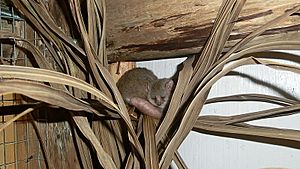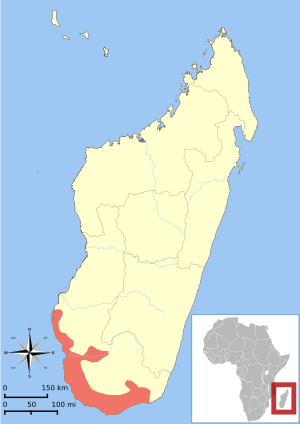Reddish-gray mouse lemur facts for kids
Quick facts for kids Reddish-gray mouse lemur |
|
|---|---|
 |
|
| Conservation status | |
| Scientific classification | |
 |
|
| Distribution of M. griseorufus |
The reddish-gray mouse lemur (Microcebus griseorufus) is a type of small lemur found only on the island of Madagascar. People sometimes call it the gray-brown mouse lemur or rufous-gray mouse lemur because of its fur color. This tiny animal lives in the western part of Madagascar, especially around the Beza Mahafaly Reserve and north towards Lamboharana.
Contents
What is a Mouse Lemur?
Mouse lemurs are the smallest primates in the world. They are named "mouse lemurs" because of their small size, big eyes, and long tails, which make them look a bit like mice. However, they are not rodents; they are a type of lemur, which are prosimian primates.
Size and Appearance
The reddish-gray mouse lemur is very small. It usually weighs about 50 to 70 grams, which is like a small apple. Its body is about 12 to 14 centimeters long, and its tail can be even longer, up to 15 centimeters. Their fur is reddish-brown or gray on their backs, and lighter, often creamy white, on their bellies. They have large, round eyes that help them see in the dark.
Where Reddish-Gray Mouse Lemurs Live
These lemurs live in the dry deciduous forests of western and southwestern Madagascar. This type of forest loses its leaves during the dry season. They prefer areas with lots of trees and bushes where they can hide and find food.
Their Home in the Forest
Reddish-gray mouse lemurs spend most of their lives in trees. They are nocturnal, meaning they are active at night. During the day, they sleep in tree holes, nests made of leaves, or dense tangles of vines. They often sleep alone or in small groups to stay safe and warm.
What Do Reddish-Gray Mouse Lemurs Eat?
Reddish-gray mouse lemurs are omnivores, which means they eat both plants and small animals. Their diet changes depending on what is available in different seasons.
- Insects: They love to eat insects like beetles, moths, and crickets. These provide important protein.
- Fruits: When fruits are ripe, they are a big part of their diet.
- Nectar: They also drink nectar from flowers, which gives them energy.
- Tree sap: Sometimes, they will lick sap from trees.
- Small vertebrates: Occasionally, they might eat very small lizards or frogs.
How They Live and Reproduce
Mouse lemurs are generally solitary when they are looking for food, but they might share sleeping spots. They communicate using different sounds, including chirps and whistles.
Life Cycle and Babies
Female reddish-gray mouse lemurs usually give birth to two or three babies at a time. The babies are born very small and helpless. They cling to their mother's fur or are left in a nest while she goes to find food. They grow quickly and become independent within a few months. In the wild, mouse lemurs can live for about 6 to 8 years, but in zoos, they can live much longer.
Are Reddish-Gray Mouse Lemurs Safe?
The reddish-gray mouse lemur is currently listed as "Least Concern" by the International Union for Conservation of Nature (IUCN). This means they are not in immediate danger of extinction. However, like many animals in Madagascar, their habitat is shrinking because of deforestation (trees being cut down) and slash-and-burn agriculture.
Conservation Efforts
Protecting their forest homes is very important for the future of reddish-gray mouse lemurs. Many organizations are working to conserve Madagascar's unique wildlife and forests. By protecting their habitat, we help ensure these tiny, fascinating lemurs continue to thrive.
Images for kids
See also
 In Spanish: Lémur ratón gris rojizo para niños
In Spanish: Lémur ratón gris rojizo para niños




